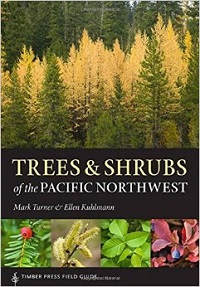Search or browse the tree fact sheets, created by Virginia Tech Department of Forest Resources and Environmental Conservation.
Keyword: Tree identification
Plant Identification: Examining Leaves
An article by Pat Breen, Oregon State Univ., Dept. of Horticulture describing common characteristics of plants that are useful in identifying them.
Bioimages
A large collection of plant images, mostly woody trees and shrubs, with various browsing methods to find the images. The most useful method is a map of North America divided into bioregions. Each bioregion has an associated list of dominant plants. Created by Steve Baskauf of Vanderbilt University.
Garden Tip #87
Trees are the answer! Or at least trees make our lives better by casting shade, cleaning the air and giving refuge to birds. It’s important to find the right tree for the right place.
- Great Plant Picks has selected plants that are proven performers in the Pacific Northwest. Complete profiles of all selected trees are available at their website www.greatplantpicks.org or give them a call to get their free booklet (206) 362-8612
- Use SelectTree, a database from the Urban Forest Ecosystems Institute to select attributes that you want your tree to possess, such as clay soil, dry, resistant to verticillium wilt and fragrant flowers (that search suggested ornamental pear). Over 1,000 trees are profiled.
- More tree information can be found at Virginia Tech Dendrology department fact sheet database, including a recording of the proper pronunciation of the Latin name. Over 800 trees are listed.
- Friends of the Trees promotes planting trees in our cities to improve our quality of life. Their website also offers tree profiles and has a list of suggested trees for planting under power lines.
Garden Tip #191
Silvics of North America Online by United States Department of Agriculture Forest Service, 1990.
Property owners with woodlots and tree lovers alike will find the Silvics of North America an informative and authoritative reference source on trees. Two hundred, mostly North American native trees are described including native habitat, associated trees and shrubs, propagation details, growth rate, and information on the major pests that may damage the tree. Many entries have information on the root development, which can be helpful in learning if a chosen tree will tolerate construction, or be appropriate for planting over water utilities.
Trees and Shrubs of the Pacific Northwest

Mark Turner, another gifted photographer, has produced his second Timber Press Field Guide: “Trees & Shrubs of the Pacific Northwest,” co-authored with Ellen Kuhlmann. As with his earlier book on the wildflowers of the region (co-authored with Phyllis Gustafson), this is designed for use in the field. Quickly accessible inside the front and back covers are diagrams of the various types of flower parts, leaves, fruits, and seeds. The cover is weather-resistant and a ruler, in both inches and centimeters is handily placed on the back cover.
This guide is also very comprehensive. “While a few readers may gripe about the size and weight of this volume, we chose to err on the side of clarity and include at least a pair of photographs for most of the 568 taxa that have a main entry.” The authors also joke that this book was “…our excuse to learn the willows” and sure enough, 28 pages are devoted to this genus that is notoriously difficult to identify at the species level.
The plant descriptions begin with conifers, followed by angiosperms divided by leaf types. There are no keys, but the extra photographs, and their high quality, makes finding plants pretty straightforward. The range maps include all of Washington and Oregon, along with southern British Columbia and northern California, showing all the counties or regional districts where the plant has been documented. The maps are a fascinating study all on their own.
The helpful introduction is only slightly modified from Turner’s earlier book, but no matter: it is useful information on how to get the best use out of this book and make the most of your plant exploration. The descriptions of the different ecoregions could make a useful booklet by itself.
Excerpted from the Fall 2014 Arboretum Bulletin.